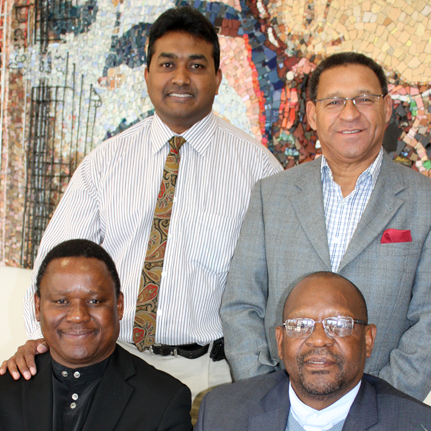|

|
|
At the conference were, from the left, front: Dr Frank Chikane, President of AFM International; Dr Mathole Motshekga, Chief Whip of the ANC; at the back: Rev. Maniraj Sukdaven, Head of our Department of Religion Studies; and Dr Alan Boesak, connected to our International Institute for Studies in Race, Reconciliation and Social Justice, as well as a minister in the United Reformed Church.
|
In recent times, reconciliation has mainly been politically driven, Dr Alan Boesak stated during a conference on religion and reconciliation. He was one of a number of prominent academic leaders from various religions who participated in the conference: Exploring religious understanding for reconciliation.The conference was presented by our Faculty of Theology and the International Institute for Studies in Race, Reconciliation and Social Justice at our university this week.
According to Dr Boesak, a theologian connected to our International Institute for Studies in Race, Reconciliation and Social Justice, reconciliation means much more than simply former enemies no longer attacking or killing one another; they also have co-exist with a positive attitude towards one another.
Speakers from, amongst others, the Christian, Jewish, Baha’i, Rastafarian, Islam and Buddhist religious communities shared their views on reconciliation with one another.Most of these speakers referred to the special value of humankind in each religion. A person’s life has a supernatural dimension, which ought to play a major role in the way in which people treat one another.
Dr Frank Chikane, President of AFM International, as well as a speaker at the event, stated that the religious community should and had to be more active in discussions about reconciliation.“If religious leaders do not talk about current issues, all kinds of voices with distorted perspectives will be heard instead,” Dr Chikane added.
Reconciliation can only truly take place if the contribution of each group in society is taken seriously. Apart from the high premium placed on rights in society, duties that have to be fulfilled should also be emphasised. Bishop Malusi Mpumlwana from the Ethiopian Episcopal Church is of the opinion that this sense of duty should be established in people’s frame of mind. Adv. Antony Osler pointed out from a Buddhist perspective how important it was to deal with reconciliation by living up to its principles.
Rev. Maniraj Sukdaven, Head of our Department of Religion Studies, is very satisfied with the high quality of the contributions during the conference.